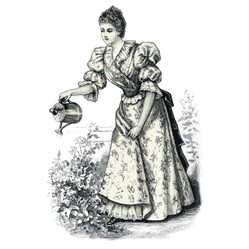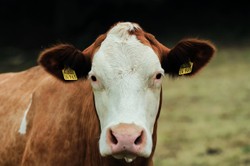The first problem that women faced was that traditional training arrangements were unsuitable, as apprentice garden boys dwelt in the garden bothy, a shack where groups of young males lived together. A female bothy did not appeal to the young, middle class girls entering gardening, for they aspired to dignity and comfort, so such conditions were unsuitable for women. Women therefore needed colleges dedicated to their training. The first such college was Swanley in Kent, established in 1889 and which began to take women in 1891, becoming women only in 1901. The first two female professional gardeners, Annie Gulvin and Alice Hutchings, who were employed at Kew Gardens, were Swanley graduates. But they suffered the problem that Kew was concerned that their loose dresses would damage plants, so they were allowed to garden in bloomers, but women in underwear attracted prurient attention, and so soon they were allowed to wear the same uniform as males: tweed jackets and breeches,caps and heavy boots. Heavy boots were considered vital for safety,even now when I took my RHS practical gardening examination, I had to have my footwear checked to see if it met safety standards.
But Swanley girls went to places, and in 1897 Annie Morrison and Lina Barker went to Edinburgh Royal Botanic Gardens and soon realized that Scotland needed its own school for women gardeners, so they established the Edinburgh school of Gardening for Women. Very soon afterwards Writtle College in the South of England went co-educational, accepting women students on gardening courses.
The Swanley girls were charged £80 a year for board, lodging and tuition, but they had to provide their own uniform, books, laundry and table napkins. Uniform was a warm tweed coat for winter and a lighter tunic for summer,blouses, stockings,belt and a felt or straw hat for summer.
There is also Lady Warwick, affectionately known as Daisy by her students. Daisy, a wealthy philanthropist committed to women's progress used her fortune to establish Lady Warwick Hostel at Reading College in Southern England, where the girls would stay in a place of safety where they would study at the college. It later moved to Studley Castle in the Midlands,where it taught its own courses and entered its students for the prestigious Royal Horticultural Society examinations.Lady Warwick eventually had to rein back her activities as she had used up much of her fortune and she stepped down from the college principal's role.
Glynde College, in Sussex, was founded by Lady Frances Wolseley, who was an enthusiastic agricultural reformer,among other good causes. It trained lady gardeners and produced Christabel Proctor,the head gardener at Girton,the then all female college in Cambridge. Not as successful as some of the others, this college closed in 1933.










 TheThousand Year Gardenon 11/26/2025
TheThousand Year Gardenon 11/26/2025
 Women of the Gospelson 10/11/2025
Women of the Gospelson 10/11/2025
 Religious Gardenson 08/25/2025
Religious Gardenson 08/25/2025
 Doctor of the Church: John Henry Newmanon 08/03/2025
Doctor of the Church: John Henry Newmanon 08/03/2025




Comments
Chickens. Lambs.calves.
The first paragraph in the first subheading, Women in the garden, considers men doing farming and women doing gardening and small animal-tending.
What kind of animal sentients were considered small animals tend-able by women?
Probably not to men asbmuch. Women head gardeners are more common nowadays in modern times and are the results of social progress.
Unitedstatesian interpretations of eastern-pond wealthiest families into the early 20th century associate women employed as cooks, governesses and housekeepers in great houses with female members of Austen and Bronte character-like families fallen on hard socioeconomic times.
Did that apply to men employed in such counterpart positions as butlers and head gardeners?
Might such a prescription, concomitantly also such a proscription, apply to the first women employed as head gardeners in great houses?
Thanks.
frankbeswick, There's a photo, available online from Catherine Horwood's Women and Their Gardens: A History from the Elizabethan Era to Today, of Cope, Hutchings and Morland in their "uniform."
Thanks Katie. Now a query. Do you grow blueberries in the same soil as the other berries that you grow? I ask this because I grow them in pots filled with [acidic] ericaceous compost as I believed my 6.5 pH soil not acidic enough.
Another question. I am dealing with blackberries that are spreading from outside the plot. How do you prevent your blackberries from spreading all over the place?
You are right, Katie, women have ever been gardeners. Not all of them, as not all men are. But even non-gardening women like my mother valued the garden, and she was dedicated to home grown and home-made foods. She always encouraged my interest, and she made a point of ensuring that we ate what I grew. When we had blackcurrants and plums she [and Veronica] turned them into jam.
This woman, for one, loves to garden. I live in the suburbs of Westerville Ohio, the population is 37,667. I have managed to take advantage of my space. I have 6 blueberry bushes, a large area of black and red raspberries, a black berry patch, grapes growing over my backyard swing a couple of apple and plum trees.and a small vegetable garden, enough to stock up and share with neighbors. I also enjoy flowers and such. Great article
This was a good practice. I see nothing like this going on today.
Almost certainly correct, but there is also the fact that the land had a sabbath. However, there was the practice of gleaning,whereby the ears of corn that fell from the plant during harvest were left for the poor, This was the practice spoken of in the book of Ruth. The same practice extended to fruit trees, which could be beaten but once for their fruit, and afterwards must be left for the poor.